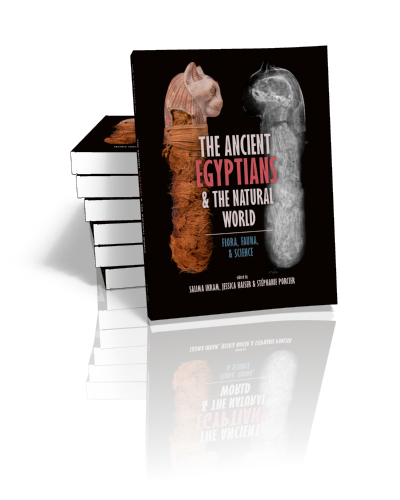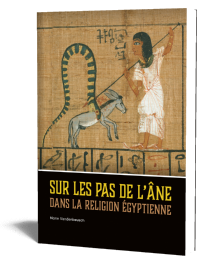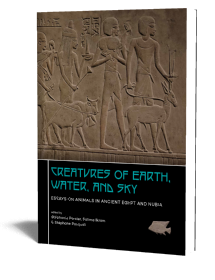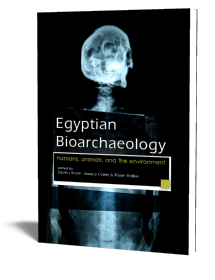The Ancient Egyptians and the Natural World
Flora, Fauna, and Science
Edited by Salima Ikram, Jessica Kaiser & Stéphanie Porcier | 2021

The Ancient Egyptians and the Natural World
Flora, Fauna, and Science
Edited by Salima Ikram, Jessica Kaiser & Stéphanie Porcier | 2021
Paperback ISBN: 9789464260359 | Hardback ISBN: 9789464260366 | Imprint: Sidestone Press | Format: 210x280mm | 284 pp. | Language: English | 57 illus. (bw) | 128 illus. (fc) | Keywords: Ancient Egypt; mummy; Amarna; animal mummy; Egyptian Museum; lion; crocodile; ibis; women; dentition; Kom Ombo; rescue archaeology; human remains; skeleton; ostrich; donkey; archaeometry; CT scan; radiography | download cover
Read online 1276 times
- Digital & Online access
-
Buy via Sidestone (EU & UK)
-
Buy via our Distributors (WORLD)
For non-EU or UK destinations you can buy our books via our international distributors. Although prices may vary this will ensure speedy delivery and reduction in shipping costs or import tax. But you can also order with us directly via the module above.
UK international distributor
USA international distributor
-
Bookinfo
Paperback ISBN: 9789464260359 | Hardback ISBN: 9789464260366 | Imprint: Sidestone Press | Format: 210x280mm | 284 pp. | Language: English | 57 illus. (bw) | 128 illus. (fc) | Keywords: Ancient Egypt; mummy; Amarna; animal mummy; Egyptian Museum; lion; crocodile; ibis; women; dentition; Kom Ombo; rescue archaeology; human remains; skeleton; ostrich; donkey; archaeometry; CT scan; radiography | download cover
Read online 1276 times

We will plant a tree for each order containing a paperback or hardback book via OneTreePlanted.org.
This book explores the interaction between animals, plants, and humans in ancient Egypt. It draws together different aspects of the bioarchaeology of Egypt: flora, fauna, and human remains. These come from sites throughout the country from Alexandria to Aswan, as well as material from museum basements.
The material presented here includes the results of new and previously unpublished excavations in the Delta and Thebes, in-depth studies of different species of animal mummies, an analysis of animal cults, tentative identifications of wild dogs in Egyptian art, a variety of diseases from which the ancient Egyptians suffered, studies on human remains using traditional as well as state-of-the-art technologies, and the different foods that formed the diet of the ancient Egyptians.
The studies blend traditional methodologies, often deployed in novel ways, such as examining the pelage of lions, as well as new 3D technologies used in the analyses of bioarchaeological material. The results of these studies deepen our knowledge of ancient Egypt, its inhabitants, and their interaction with their environment.
The present volume is the proceedings of the Conference on the Bioarchaeology of Ancient Egypt & the Second International Symposium on Animals in Ancient Egypt (Cairo, 2019).
Curatorial Training in Human Remains for the Egyptian Museum, Cairo.
Hasnaa Askalany & Gehad Shawky Ibrahem
Hyperostosis frontalis interna in the Early Dynastic Period at Abydos, Egypt.
Brenda J. Baker & Ahmed Mohamed Gabr
Humans and Animals together in the Journey to the Afterlife. The Burial in Area R11 under the Temple of Millions of Years of Amenhotep II, Luxor, West Thebes – Italian Archaeological Project.
Fabio Bona, Giovanna Bellandi, Letizia Cavallini, Anna Consonni, Tommaso Quirino & Angelo Sesana
To Be or Not to Be a Dog Mummy: How a Metric Study of the Skull can Inform on Selection Practices Pertaining to Canid Mummification in Ancient Egypt.
Colline Brassard, Stéphanie Porcier & Cécile Callou
Newcomers in the Bestiary. A Review of the Presence of Lycaon pictus in Late Predynastic and Early Dynastic Environment and Iconography.
Axelle Brémont
Dévots et animaux sacrés.
Alain Charron
Tuberculosis at Tell-el Amarna: A Theoretical Exercise in the Economic and Social Effects of Chronic, Terminal Disease in Ancient Egypt.
Gretchen R. Dabbs
Burial Practices in the West Delta: Cases from Kom Aziza.
Shereen El-Morsi & Aya M. Salem
A Structure-from-Motion Pipeline for Bone Morphology 3D Analysis.
Margaret Farmer & Angelique Corthals
Lions and Science and Whorls, Oh My!
Karen Polinger Foster
Human and Faunal Remains in Egypt: A New Department and a New Approach.
Zeinab Hashesh & Ahmed Gabr
Creatures of the Sun, Creatures of the Moon: Animal Mummies from Lisbon’s National Archaeological Museum.
Salima Ikram, Carlos Prates, Sandra Sousa & Carlos Oliveira
Brief Notes about a Mummified Crocodile from the National Archaeological Museum (MANN) of Naples, Italy.
Ilaria Incordino & Cinzia Oliva
Faunal Remains at the Causeway of Sahura.
Mohamed Ismail Khaled & Mohamed Hussein Ahmed
Venerunt, Viderunt, Vicerunt: The Roman Conquest and the Non-Elite.
Jessica Kaiser
Interactions Between Teeth and Their Environment: A Study of the Effect on Age Estimation.
Casey L. Kirkpatrick
Discovery of an Unexpected Textile Fiber in a Fish Mummy from the Musée des Conflunces (Lyon) Collection.
Fleur Letellier-Willemin
Women’s Health Issues Reflected in Case Studies from Theban Tomb 16.
Suzanne Onstine, Jesus Herrerín, Miguel Sanchez & Rosa Dinarès
Analyse des gazelles momifiées de Kom Mereh/Komir (Haute Egypte) conservées au Musée des Confluences (Lyon, France).
Stéphanie Porcies & Louis Chaix
Did Egyptians Eat Donkeys? Reflections from Historical and Archaeological Data.
Mathilde Prévost & Joséphine Lesur
What I Have Learned: Assumptions Bad, Intersections Good.
Richard W. Redding
Biomolecular Stable Isotope and Carbon-14 Dates of Ancient Egyptian Food Offerings: A Case Study from a Provincial Cemetery of Deir el-Ballas.
Amr Khalaf Shahat & Victoria Jensen
Animal Butchering Technology in Old and Middle Kingdom Egypt: The Shift from Stone to Metal Tools.
Eleuterio Sousa & Haskel J. Greenfield
Anthropological Study of the Egyptian Mummy from the Pushkin State Museum of Fine Arts Using Computed Tomography.
Sergey Vasilyev, E.B. Yatsishina, R.M. Galeev, S.B. Borustkaya, M.V. Kovalchuk, O.A. Vasilieva, O.P. Dyuzheva & V.L. Ushakov
Intentionally Burnt Human Remains from the Kom Ombo Temple Salvage Excavation.
Afaf Wahba
Salima Ikram
Salima Ikram is Distinguished University Professor of Egyptology at the American University in Cairo, and has excavated extensively in Egypt as well as in Turkey. She has directed the Animal Mummy Project, the Amenmesse Project (KV10/KV63), the North Kharga Oasis Darb Ain Amur Project, and headed the archaeozoology team at Kinet Hoyuk in Turkey.
Jessica Kaiser
Jessica Kaiser is a visiting researcher and lecturer at the Department of Near Eastern Studies at the University of California Berkeley and Adjunct Assistant Professor of Anthropology at Saint Mary’s College of California. She holds an MA in biological anthropology from the University of Stockholm, Sweden, with minors in Classics and Egyptology from Uppsala University (2006) and a PhD in Egyptian Archaeology and Bioarchaeology from University of California Berkeley (2018).
Stéphanie Porcier
Stéphanie Porcier is an Egyptologist and Archeozoologist specializing in the study of animals in ancient Egypt and especially animal mummies. She directs the inter- and multidisciplinary program MAHES (French acronym for Egyptian Animal and Human Mummies) which aims to study the most important collection of animal mummies outside Egypt kept at the Musée des Confluences, Lyon (France).
Abstract:
This book explores the interaction between animals, plants, and humans in ancient Egypt. It draws together different aspects of the bioarchaeology of Egypt: flora, fauna, and human remains. These come from sites throughout the country from Alexandria to Aswan, as well as material from museum basements.
The material presented here includes the results of new and previously unpublished excavations in the Delta and Thebes, in-depth studies of different species of animal mummies, an analysis of animal cults, tentative identifications of wild dogs in Egyptian art, a variety of diseases from which the ancient Egyptians suffered, studies on human remains using traditional as well as state-of-the-art technologies, and the different foods that formed the diet of the ancient Egyptians.
The studies blend traditional methodologies, often deployed in novel ways, such as examining the pelage of lions, as well as new 3D technologies used in the analyses of bioarchaeological material. The results of these studies deepen our knowledge of ancient Egypt, its inhabitants, and their interaction with their environment.
The present volume is the proceedings of the Conference on the Bioarchaeology of Ancient Egypt & the Second International Symposium on Animals in Ancient Egypt (Cairo, 2019).
Contents
Curatorial Training in Human Remains for the Egyptian Museum, Cairo.
Hasnaa Askalany & Gehad Shawky Ibrahem
Hyperostosis frontalis interna in the Early Dynastic Period at Abydos, Egypt.
Brenda J. Baker & Ahmed Mohamed Gabr
Humans and Animals together in the Journey to the Afterlife. The Burial in Area R11 under the Temple of Millions of Years of Amenhotep II, Luxor, West Thebes – Italian Archaeological Project.
Fabio Bona, Giovanna Bellandi, Letizia Cavallini, Anna Consonni, Tommaso Quirino & Angelo Sesana
To Be or Not to Be a Dog Mummy: How a Metric Study of the Skull can Inform on Selection Practices Pertaining to Canid Mummification in Ancient Egypt.
Colline Brassard, Stéphanie Porcier & Cécile Callou
Newcomers in the Bestiary. A Review of the Presence of Lycaon pictus in Late Predynastic and Early Dynastic Environment and Iconography.
Axelle Brémont
Dévots et animaux sacrés.
Alain Charron
Tuberculosis at Tell-el Amarna: A Theoretical Exercise in the Economic and Social Effects of Chronic, Terminal Disease in Ancient Egypt.
Gretchen R. Dabbs
Burial Practices in the West Delta: Cases from Kom Aziza.
Shereen El-Morsi & Aya M. Salem
A Structure-from-Motion Pipeline for Bone Morphology 3D Analysis.
Margaret Farmer & Angelique Corthals
Lions and Science and Whorls, Oh My!
Karen Polinger Foster
Human and Faunal Remains in Egypt: A New Department and a New Approach.
Zeinab Hashesh & Ahmed Gabr
Creatures of the Sun, Creatures of the Moon: Animal Mummies from Lisbon’s National Archaeological Museum.
Salima Ikram, Carlos Prates, Sandra Sousa & Carlos Oliveira
Brief Notes about a Mummified Crocodile from the National Archaeological Museum (MANN) of Naples, Italy.
Ilaria Incordino & Cinzia Oliva
Faunal Remains at the Causeway of Sahura.
Mohamed Ismail Khaled & Mohamed Hussein Ahmed
Venerunt, Viderunt, Vicerunt: The Roman Conquest and the Non-Elite.
Jessica Kaiser
Interactions Between Teeth and Their Environment: A Study of the Effect on Age Estimation.
Casey L. Kirkpatrick
Discovery of an Unexpected Textile Fiber in a Fish Mummy from the Musée des Conflunces (Lyon) Collection.
Fleur Letellier-Willemin
Women’s Health Issues Reflected in Case Studies from Theban Tomb 16.
Suzanne Onstine, Jesus Herrerín, Miguel Sanchez & Rosa Dinarès
Analyse des gazelles momifiées de Kom Mereh/Komir (Haute Egypte) conservées au Musée des Confluences (Lyon, France).
Stéphanie Porcies & Louis Chaix
Did Egyptians Eat Donkeys? Reflections from Historical and Archaeological Data.
Mathilde Prévost & Joséphine Lesur
What I Have Learned: Assumptions Bad, Intersections Good.
Richard W. Redding
Biomolecular Stable Isotope and Carbon-14 Dates of Ancient Egyptian Food Offerings: A Case Study from a Provincial Cemetery of Deir el-Ballas.
Amr Khalaf Shahat & Victoria Jensen
Animal Butchering Technology in Old and Middle Kingdom Egypt: The Shift from Stone to Metal Tools.
Eleuterio Sousa & Haskel J. Greenfield
Anthropological Study of the Egyptian Mummy from the Pushkin State Museum of Fine Arts Using Computed Tomography.
Sergey Vasilyev, E.B. Yatsishina, R.M. Galeev, S.B. Borustkaya, M.V. Kovalchuk, O.A. Vasilieva, O.P. Dyuzheva & V.L. Ushakov
Intentionally Burnt Human Remains from the Kom Ombo Temple Salvage Excavation.
Afaf Wahba
Salima Ikram
Salima Ikram is Distinguished University Professor of Egyptology at the American University in Cairo, and has excavated extensively in Egypt as well as in Turkey. She has directed the Animal Mummy Project, the Amenmesse Project (KV10/KV63), the North Kharga Oasis Darb Ain Amur Project, and headed the archaeozoology team at Kinet Hoyuk in Turkey.
Jessica Kaiser
Jessica Kaiser is a visiting researcher and lecturer at the Department of Near Eastern Studies at the University of California Berkeley and Adjunct Assistant Professor of Anthropology at Saint Mary’s College of California. She holds an MA in biological anthropology from the University of Stockholm, Sweden, with minors in Classics and Egyptology from Uppsala University (2006) and a PhD in Egyptian Archaeology and Bioarchaeology from University of California Berkeley (2018).
Stéphanie Porcier
Stéphanie Porcier is an Egyptologist and Archeozoologist specializing in the study of animals in ancient Egypt and especially animal mummies. She directs the inter- and multidisciplinary program MAHES (French acronym for Egyptian Animal and Human Mummies) which aims to study the most important collection of animal mummies outside Egypt kept at the Musée des Confluences, Lyon (France).
- Digital & Online access
-
Buy via Sidestone (EU & UK)
-
Buy via our Distributors (WORLD)
For non-EU or UK destinations you can buy our books via our international distributors. Although prices may vary this will ensure speedy delivery and reduction in shipping costs or import tax. But you can also order with us directly via the module above.
UK international distributor
USA international distributor
- Browse all books by subject
-
Search all books

We will plant a tree for each order containing a paperback or hardback book via OneTreePlanted.org.
You might also like:
© 2025 Sidestone Press KvK nr. 28114891 Privacy policy Sidestone Newsletter Terms and Conditions (Dutch)








